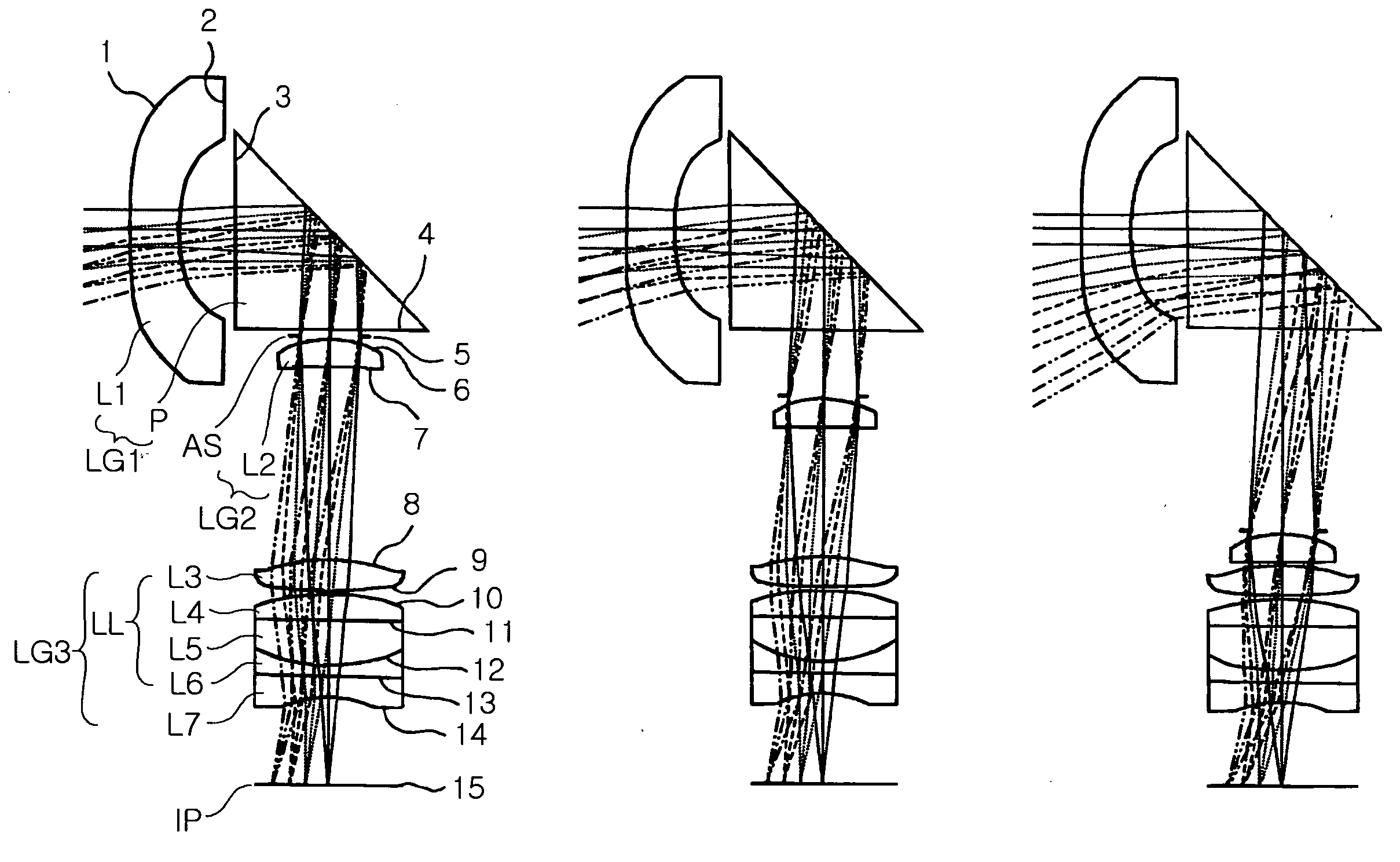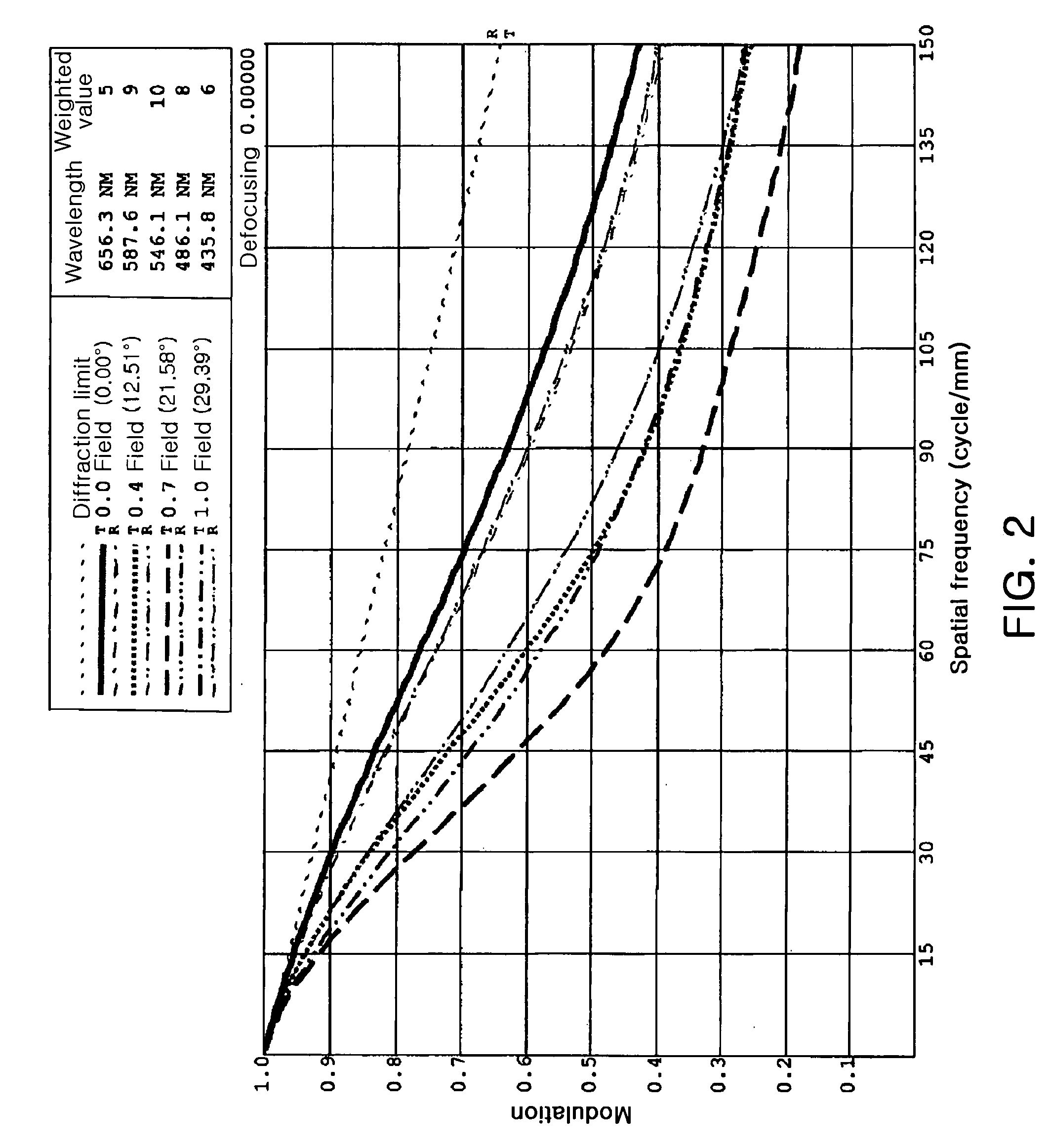Zoom optical system having liquid lens
a technology of optical system and liquid lens, applied in the field of zoom optical system, can solve the problems of increasing hindering the miniaturization of the camera module, and increasing the weight and power consumption, so as to reduce mechanical limitation, power consumption and weight
- Summary
- Abstract
- Description
- Claims
- Application Information
AI Technical Summary
Benefits of technology
Problems solved by technology
Method used
Image
Examples
example 1
[0092]The following Table 1 shows numeric data by Example 1 according to the present invention.
TABLE 1ThicknessAbbeSurfaceRadius oforRefractivenumberNo.curvature Rdistance tindex NdVdOther*1205.3481.3001.71247.6First lens*25.7291.5003∞5.2201.50956.4Prism4∞variable 15∞0.100Aperturestop*63.4930.7181.48770.4Second lens*742.159variable 2*85.5170.8001.48770.4Third lens*9−13.5640.100106.6790.6721.48770.4Fourth lens11∞variable 31.41633.5Fifth lens12variable 5variable 41.51722.3Sixth lens13∞0.5581.75527.6Seventh lens143.2602.31515∞—Image plane
[0093]In addition, FIG. 1 is the lens arrangement of the zoom optical system according to Example 1 of the present invention, in which (a) is at a telephoto end, (b) is at a middle end and (c) is at a wide angle end. FIGS. 2 to 4 are graphs showing the Modulation Transfer Function (MTF) characteristics of the zoom optical system shown in FIG. 1 at a wide angle end, a middle end and a telephoto end, respectively, and FIGS. 5 to 7 are graphs showing...
example 2
[0101]The following Table 5 shows numeric data by Example 2 according to the present invention.
TABLE 5ThicknessAbbeSurfaceRadius oforRefractivenumberNo.curvature Rdistance tindex NdVdNote*120.0000.8261.74444.9First lens*25.1001.2593∞5.2201.50956.4Prism4∞variable 15∞0.100Aperturestop*62.0571.1351.48770.4Second lens*73.693variable 283.2980.9041.62060.3Third lens9∞variable 31.41633.5Fourth lens10variable 5variable 41.51722.3Fifth lens11∞0.4001.75527.6Sixth lens122.8420.300*132.1950.8501.62060.3Seventh lens*144.5561.56415∞—Image plane
[0102]In addition, FIG. 8 illustrates the lens arrangement of the zoom optical system according to Example 2, in which (a) is at a telephoto end, (b) is at a middle end and (c) is at a wide angle end. FIGS. 9 to 11 are graphs illustrating the MTF characteristics of the zoom optical system shown in FIG. 8 at a wide angle end, a middle end and a telephoto end, respectively. FIGS. 12 to 14 are graphs illustrating spherical aberration, astigmatism and dist...
example 3
[0107]Table 9 shows numeric data by Example 3 according to the present invention.
TABLE 9ThicknessAbbeSurfaceRadius oforRefractivenumberNo.curvature Rdistance tindex NdVdNote*120.0000.8981.50660.8First lens*25.1001.5003−15.0005.2201.50956.4Prism414.692variable 15∞0.100Aperturestop*61.7351.4001.48770.4Second lens*73.667variable 283.1740.8821.48770.4Third lens9∞variable 31.41633.5Fourth lens10variable 5variable 41.51722.3Fifth lens11∞0.4001.75527.6Sixth lens122.6660.631*132.3980.8501.62060.3Seventh lens*144.4751.16215∞—Image plane
[0108]In addition, FIG. 15 is the lens arrangement of the zoom optical system by Example 3 according to the present invention, in which (a) is at a telephoto end, (b) is at a middle end and (c) is at a wide angle end. FIGS. 16 to 18 are graphs illustrating the MTF characteristics of the zoom optical system shown in FIG. 15 at a wide angle end, middle end, telephoto end. FIGS. 19 to 21 are graphs illustrating aspherical aberration, astigmatism and distorti...
PUM
 Login to View More
Login to View More Abstract
Description
Claims
Application Information
 Login to View More
Login to View More - R&D
- Intellectual Property
- Life Sciences
- Materials
- Tech Scout
- Unparalleled Data Quality
- Higher Quality Content
- 60% Fewer Hallucinations
Browse by: Latest US Patents, China's latest patents, Technical Efficacy Thesaurus, Application Domain, Technology Topic, Popular Technical Reports.
© 2025 PatSnap. All rights reserved.Legal|Privacy policy|Modern Slavery Act Transparency Statement|Sitemap|About US| Contact US: help@patsnap.com



